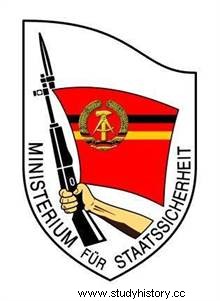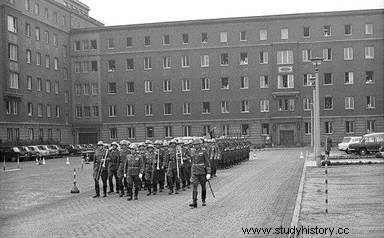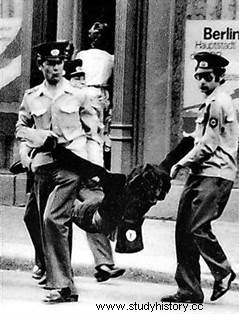 Now defunct, the Stasi was the political police, the espionage and counterintelligence service of the German Democratic Republic, created in 1949 and disappeared in 1990 with reunification. Its name comes from the diminutive of Staatssicherheitsdienst, which designates the security services of the former GDR. The main purpose of the Stasi was to spy on the actions of the East German population, to suppress political opposition and to monitor evangelical churches and other religious organizations. Sprawling and feared bureaucracy, it was unable to prevent and prevent the fall of the Berlin Wall.
Now defunct, the Stasi was the political police, the espionage and counterintelligence service of the German Democratic Republic, created in 1949 and disappeared in 1990 with reunification. Its name comes from the diminutive of Staatssicherheitsdienst, which designates the security services of the former GDR. The main purpose of the Stasi was to spy on the actions of the East German population, to suppress political opposition and to monitor evangelical churches and other religious organizations. Sprawling and feared bureaucracy, it was unable to prevent and prevent the fall of the Berlin Wall.
The Stasi:“The shield and sword of the Party”
As early as 1950, when the SED – Unified Socialist Party – assumed all powers, the Ministry of State Security – better known as the Stasi – see the day. It is then a simple tool of repression in order to best ensure the transition to socialism. But, in 1953, the workers, disappointed and dissatisfied with the regime, revolted. This episode is decisive for the future development of the Stasi, which was unable to anticipate the revolt. The turning point came in 1957, the year in which Erich Mielke was appointed Minister of Security, a position he held until 1989. With the mission of reorganizing the Stasi, he offered him the means to observe, to spy on the life East Germans, to detect and deter opponents of the regime.
While it initially had a few thousand officers, the number soared to reach the figure of 80,000 officers in the 1980s, all trained in a higher school of law, located in Potsdam-Eiche, called the Juristische Hochschusle. But these officers did not act alone, and had to recruit Inoffizielle Mitarbeiter (IM) – or unofficial informant – who are estimated at 200,000 at the fall of the regime. These IMs were in fact ordinary East German citizens who were called upon to collaborate with the Stasi. They were therefore not members of the structure strictly speaking, but they at least had to provide reports to their officer-director. These informants were recruited from among the entourage of a suspected person, from friends in associations to family, some only having sporadic ties with them.
 From the archives, we know that the quality and quantity of information provided by these informants varied between individuals :some provided meager reports of no particular interest, while the relatives of the suspected person provided much more regular and complete reports. The information gathered was therefore of very uneven value:some reports mention only a brief encounter in the street, while some informants reported entire conversations.
From the archives, we know that the quality and quantity of information provided by these informants varied between individuals :some provided meager reports of no particular interest, while the relatives of the suspected person provided much more regular and complete reports. The information gathered was therefore of very uneven value:some reports mention only a brief encounter in the street, while some informants reported entire conversations.
Thanks to these IMs, the Stasi truly managed to penetrate into the life of the "monitored", so much so that it controlled almost all the social ties of the person under surveillance. In the end, it looks like a denunciation operation, not spontaneous but carefully organized by the Stasi. It also allowed the informer to place himself as a good socialist, ready to serve the regime.
An extensive surveillance arsenal
The Stasi was neatly divided into sections, each specializing in one type of operation. While one was specialized in telephone tapping, another was in charge of installing microphones in a room, making it possible to interfere more in people's private lives. Mail was tracked by Section M, as opponents sometimes had links with foreign organizations. Private life is under the control of the Stasi, supported by a legislative framework, which this secret police do not hesitate to override if ever there is constraint.
Section XX, is assigned the surveillance of the State apparatus, the Churches, the cultural field and the so-called "underground political activity", implying the networks of opposition. It is this combination of different complementary sections that makes the Stasi an effective tool for gathering information. When a person appears suspicious, the officers do not hesitate to manipulate the head of work of this person, in order to put him under close surveillance at his place of work:his actions and gestures could be observed throughout the day. The strength of the Stasi is seen through its cooperation with the Volkspolizei (People's Police):but the latter was hierarchically subordinate to the Stasi, and thus became its mere extension.
Observe and deter opponents
It is obvious that not all East German citizens were observed by the Stasi, but the surveillance was organized methodically around opposition cores. So what were these nuclei during the golden age of Stasi surveillance – which we place from the 1970s to the end of the GDR? A little explanation is needed. Honecker, first secretary of the SED from 1976 to 1989 advanced the idea of an "armed peace" to justify the militarization of society. This armed peace was accompanied by the creation of associations for peace, for example Women for Peace in 1982. But these peace movements gradually became politicized and became opposition circles, with demands now on democratic rights, emancipation. It is therefore around these groups that the Stasi's investigations are concentrated, eavesdropping is increasing, informants are springing up.
 Second opposition pole accused of carrying out "anti-socialist activities", closely linked to peace movements , the Church and religious circles. The activities of the Stasi are therefore concentrated on these two niches of opponents, each member of these movements being carefully observed in order to measure their position vis-à-vis the regime and their intentions. So, what if the Stasi had proof that a person or a movement had foreign relations, or planned to carry out operations that offended the GDR? The Stasi's methods were ultimately relatively mild.
Second opposition pole accused of carrying out "anti-socialist activities", closely linked to peace movements , the Church and religious circles. The activities of the Stasi are therefore concentrated on these two niches of opponents, each member of these movements being carefully observed in order to measure their position vis-à-vis the regime and their intentions. So, what if the Stasi had proof that a person or a movement had foreign relations, or planned to carry out operations that offended the GDR? The Stasi's methods were ultimately relatively mild.
First solution, the infiltration of opposition circles, attacking the roots of the problem. By recruiting an informant within an association or the Church itself, the Stasi spread false information about a suspected person, so that the latter was discredited and excluded from the movement. In the eyes of his entourage, the suspect passed for a "reactionary" wishing to overthrow the regime. Second solution, create a situation of insecurity within a group or association suspected of being a pole of opposition, by proceeding by sending anonymous letters to certain members and spreading rumors about the intentions of such and such a person.
A more drastic means, psychological terror was also a deterrent, and if it made you smile, it was just as effective. The evocation of the Stasi caused great fear among East Germans, often arousing a certain paranoia within East German society. This psychological terror was intended to "cause the basis of a certain resignation", through operations of "psychological destruction and destabilization".
Stasi agents, well trained in the field of psychology, showed great inventiveness:they organized "conspiratorial searches", violated the privacy of the suspect for example by making all the rolls of toilet paper disappear, personal items, or by mysteriously repetitively puncturing the opponent's bicycle or car! All this for the sole purpose of instilling mistrust. And if the opponent did not resign himself, he could then be summoned to an interrogation in order to "teach him a lesson". However, the use of violence or torture was extremely rare, the means of pressure of the secret services of the Stasi were more psychological than physical. The Stasi thus has a wide range of solutions to destabilize the opponent, the last being the most radical:imprisonment.
Fall of the wall and the Stasi
 The practices of the Stasi have undoubtedly fueled many fantasies and aroused the paranoia of East Germans. During its reorganization during the 1960s, the Stasi became a true observation police, accumulating paperwork, reports and archives. This very large structure even appealed to the goodwill of East German society. However, this permanent surveillance did not make it possible to stifle the opposition circles:on the contrary, it only increased the ardor of the opponents. Thus, on November 9, 1989, the Berlin Wall fell. An event that the Stasi had not been able to foresee, reflecting the limits of this vast structure, which nevertheless observed everything.
The practices of the Stasi have undoubtedly fueled many fantasies and aroused the paranoia of East Germans. During its reorganization during the 1960s, the Stasi became a true observation police, accumulating paperwork, reports and archives. This very large structure even appealed to the goodwill of East German society. However, this permanent surveillance did not make it possible to stifle the opposition circles:on the contrary, it only increased the ardor of the opponents. Thus, on November 9, 1989, the Berlin Wall fell. An event that the Stasi had not been able to foresee, reflecting the limits of this vast structure, which nevertheless observed everything.
After the collapse of the Berlin Wall and the communist regime, the powerful Security Minister and head of the Stasi Erich Mielke was imprisoned and the institution was officially abolished. Thousands of officials were removed from their posts and much of their impressive archives were made available to the public (they are stored in a shelter with 180 km of shelving and are currently being classified).
It was then discovered that the Stasi had employed 85,000 people and 500,000 informants, without it being always possible to establish their identity with certainty. Thus, many people were accused of having been members of the Stasi; for example, the Christian Democrat Lothar de Maizière, who resigned from the federal government in December 1990, after being unjustly accused of having worked for the Stasi. Still others, like the novelist Christa Wolf, were accused of being informants.
After the liquidation of the Stasi and then the German reunification in 1990, the "law on the files of the STASI" was adopted in December 1991. Each citizen concerned could then consult his own file in the Stasi archives. This law is also a godsend for the historian, who can thereby gain a deeper understanding of the functioning of this famous institution.
Bibliography
- Lorrain Sophie, History of the GDR, Paris, PUF, What do I know?, 1994
- Poppe, Ulrike, “What do we read when we read a STASI personal file? », Genèses n°52, sept 2003, p 119-132
